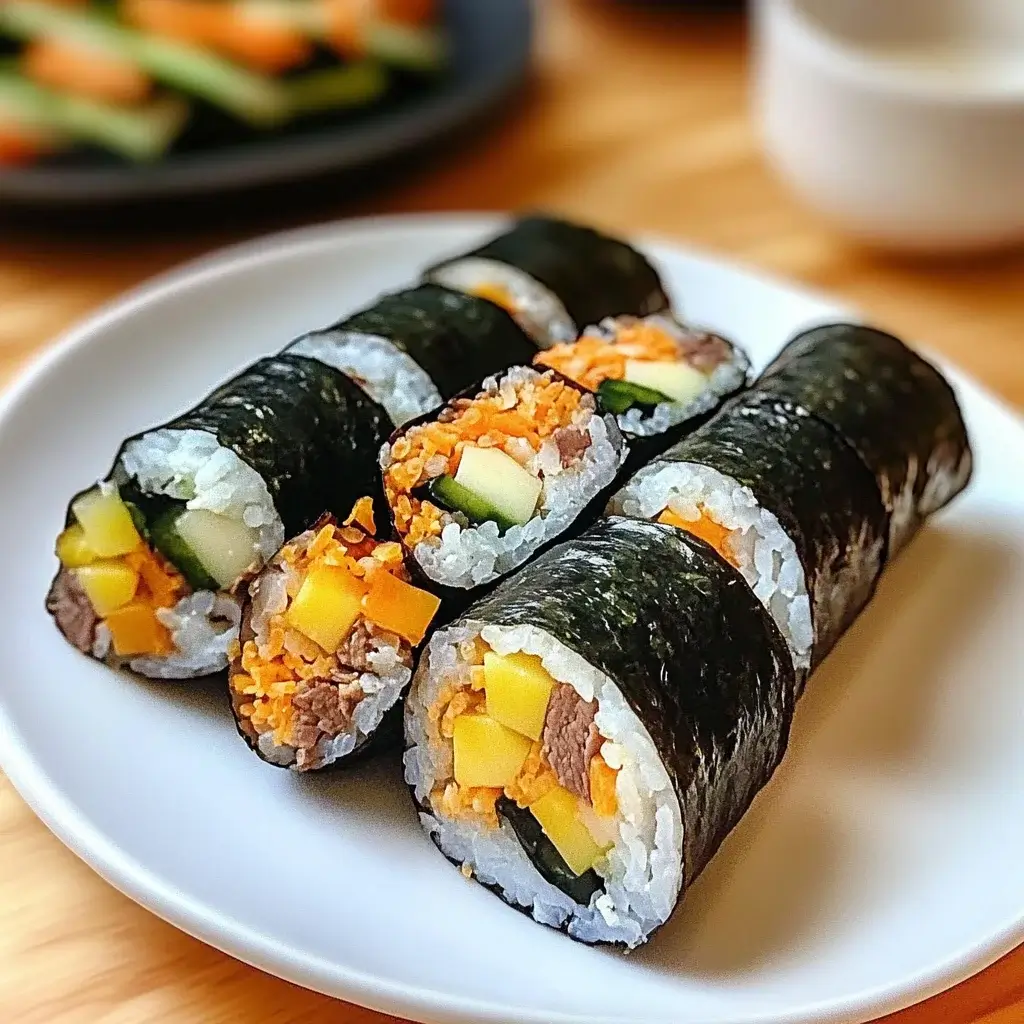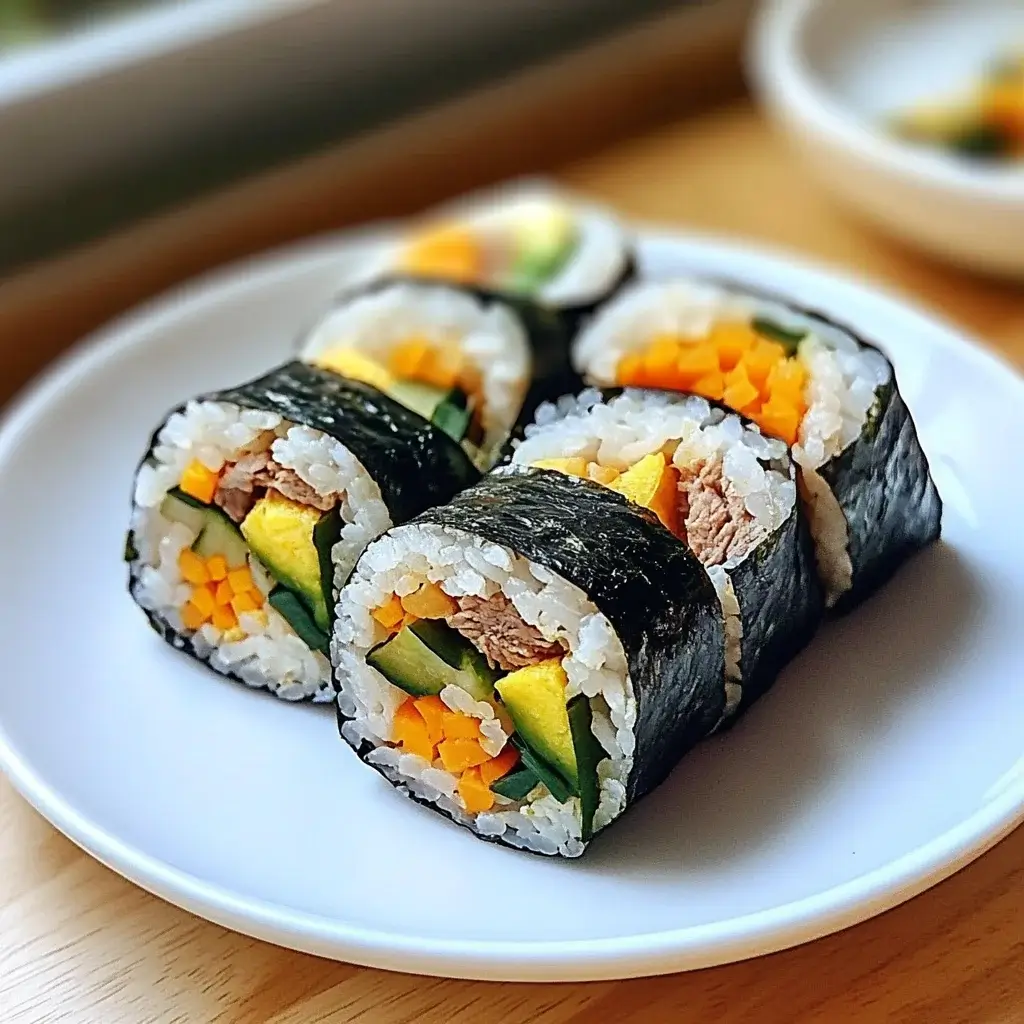
Introduction
Take your taste buds on a flavorful journey with Korean Beef Kimbap, a vibrant and satisfying dish that wraps bold ingredients into perfect bite-sized rolls. Featuring tender, savory bulgogi-style beef, crisp vegetables, fluffy rice, and toasted seaweed, this colorful Korean classic is as fun to make as it is to eat. Whether you’re packing a lunchbox, preparing a picnic, or hosting a casual dinner, this kimbap delivers the perfect balance of texture, taste, and tradition.
Why You’ll Love This Recipe:
-
Savory-Sweet Beef Filling: Marinated beef adds rich umami with a touch of sweetness.
-
Fresh & Colorful Ingredients: A beautiful mix of textures—from crunchy carrots to soft rice.
-
Fun to Roll & Share: Great for gatherings or hands-on meals with family and friends.
-
Healthier than Takeout: Homemade, customizable, and packed with nutritious ingredients.
-
Perfect for On-the-Go: Easy to slice, store, and enjoy anywhere—no dipping sauce required!
Ingredients
The star of the show—bold, flavorful, and impossible to miss. Here’s what you’ll need:
- Cooked short-grain rice: This is the base of your kimbap, providing a sticky texture that holds everything together.
- Sesame oil: A drizzle of this fragrant oil adds a nutty flavor that elevates the dish.
- Salt: Just a pinch enhances the overall taste of the rice.
- Nori (seaweed): These sheets wrap around the fillings, giving kimbap its signature look and flavor.
- Cooked beef (like bulgogi): Thinly sliced, this tender meat is the star of the show, bringing savory goodness to each bite.
- Fresh spinach: Blanched spinach adds a pop of color and a nutritious crunch.
- Carrot: Julienned for a sweet, crunchy texture that complements the beef.
- Pickled radish: These strips provide a tangy contrast that balances the flavors beautifully.
- Sesame seeds (optional): A sprinkle on top adds a delightful crunch and visual appeal.
- Soy sauce for dipping (optional): A savory dip that enhances the flavors of the kimbap.
For those looking to mix things up, consider substituting the beef with tofu or adding more veggies like cucumber or bell peppers. You can find the exact quantities for each ingredient at the bottom of the article, ready for printing!
How to Make Korean Beef Kimbap
Step 1: Prepare the Rice Mixture
Start by placing your cooked short-grain rice in a large bowl. Drizzle in the sesame oil and sprinkle the salt over the rice. Using a spatula or wooden spoon, gently mix everything together. You want the rice to be evenly coated and slightly sticky, which helps it hold together later. This step is crucial for achieving that perfect kimbap texture!
Step 2: Assemble the Kimbap
Now, grab a sheet of nori and lay it shiny side down on a bamboo sushi mat or a clean surface. With wet hands to prevent sticking, spread about half a cup of the rice mixture evenly over the nori. Leave about an inch of space at the top. This will help seal the roll later. Make sure the rice is spread out evenly for a balanced bite!
Step 3: Add Fillings
It’s time to layer in the good stuff! Place a line of thinly sliced beef, blanched spinach, julienned carrot, and pickled radish across the center of the rice. Don’t overstuff; you want to keep it manageable. Each filling adds its own flavor and texture, creating a delightful combination in every bite. Trust me, this is where the magic happens!
Step 4: Roll the Kimbap
Starting from the bottom, carefully roll the nori away from you, using the mat to keep it tight. Press gently as you roll to ensure everything stays in place. When you reach the top edge, wet it slightly to help seal the roll. A tight roll means better slices later, so take your time with this step!
Step 5: Slice and Serve
Once all your rolls are made, it’s time to slice them into bite-sized pieces. Use a sharp knife and wipe it with a damp cloth between cuts for cleaner slices. Arrange the kimbap on a plate, and if you like, sprinkle some sesame seeds on top. Serve with soy sauce for dipping, and enjoy the deliciousness of your homemade Korean Beef Kimbap!

Tips for Success
- Use short-grain rice for the best texture; it’s stickier and holds together well.
- Keep your hands wet while handling the rice to prevent sticking.
- Don’t overfill the kimbap; a little goes a long way for easier rolling.
- For cleaner slices, use a sharp knife and wipe it between cuts.
- Experiment with fillings to find your favorite combinations!
Equipment Needed
- Bamboo sushi mat: This helps in rolling the kimbap tightly. If you don’t have one, a clean kitchen towel works too.
- Sharp knife: Essential for slicing the rolls. A serrated knife can also do the trick.
- Large bowl: For mixing the rice and ingredients.
Variations
- Vegetarian Kimbap: Swap the beef for marinated tofu or additional vegetables like cucumber, bell peppers, or avocado for a fresh twist.
- Spicy Kimbap: Add a drizzle of gochujang (Korean chili paste) to the rice mixture for a spicy kick that elevates the flavor.
- Breakfast Kimbap: Incorporate scrambled eggs or omelet strips for a hearty breakfast option that’s perfect for on-the-go mornings.
- Seafood Kimbap: Use cooked shrimp or crab meat instead of beef for a delightful seafood variation that’s equally delicious.
- Kimchi Kimbap: Add a layer of kimchi for a tangy, fermented flavor that complements the other ingredients beautifully.
Serving Suggestions
- Pair your Korean Beef Kimbap with a side of kimchi for a spicy kick.
- Serve with pickled vegetables to enhance the flavors.
- A refreshing cucumber salad complements the dish perfectly.
- Enjoy with a cold bottle of Korean beer or iced green tea.
- For presentation, slice the kimbap into even pieces and arrange them on a colorful platter.
FAQs about Korean Beef Kimbap
What is Korean Beef Kimbap?
Korean Beef Kimbap is a delicious dish made with seasoned rice, fresh vegetables, and thinly sliced beef, all rolled in nori (seaweed). It’s a popular Korean meal that’s perfect for lunch or a quick dinner.
Can I make Kimbap ahead of time?
Absolutely! You can prepare Korean Beef Kimbap a few hours in advance. Just keep it wrapped in plastic wrap to maintain freshness. However, it’s best enjoyed the same day for optimal flavor and texture.
Is Kimbap gluten-free?
Yes, Korean Beef Kimbap can be gluten-free if you use gluten-free soy sauce for dipping. The main ingredients, like rice and vegetables, are naturally gluten-free, making it a great option for those with dietary restrictions.
What can I substitute for beef in Kimbap?
If you’re looking for alternatives, try using marinated tofu, grilled chicken, or even seafood like shrimp. These options can add a unique twist to your Korean Beef Kimbap while keeping it delicious!
How do I store leftover Kimbap?
Store any leftover Korean Beef Kimbap in an airtight container in the refrigerator. It’s best consumed within a day or two. Just remember that the rice may lose some of its texture over time.
Final Thoughts
Making Korean Beef Kimbap is more than just preparing a meal; it’s about creating a moment to share with family and friends. The joy of rolling those vibrant ingredients together, the aroma of sesame oil wafting through the kitchen, and the satisfaction of slicing into those perfectly crafted rolls is truly rewarding. Each bite is a delightful explosion of flavors and textures, reminding me of the warmth of home-cooked meals. Whether you’re enjoying it on a busy weekday or at a weekend gathering, this kimbap is sure to bring smiles and satisfaction to your table!
Korean Beef Kimbap: Uncover the Delicious Recipe Today!
Ingredients
Method
- In a large bowl, combine the cooked rice, sesame oil, and salt. Mix well until the rice is evenly coated and slightly sticky.
- Place a sheet of nori on a bamboo sushi mat or a clean surface, shiny side down. With wet hands, spread about 1/2 cup of the rice mixture evenly over the nori, leaving a 1-inch border at the top.
- Arrange a line of beef, spinach, carrot, and pickled radish across the center of the rice.
- Starting from the bottom, carefully roll the nori away from you, using the mat to help keep the roll tight. Press gently to seal the edge of the nori.
- Repeat the process with the remaining sheets of nori and filling ingredients.
- Once all rolls are made, use a sharp knife to slice each roll into bite-sized pieces. Wipe the knife with a damp cloth between cuts for cleaner slices.
- Sprinkle sesame seeds on top if desired and serve with soy sauce for dipping.
Nutrition
Notes
- For a vegetarian version, replace the beef with tofu or additional vegetables like cucumber or bell peppers.
- Add a splash of rice vinegar to the rice for a tangy flavor, or include other fillings like avocado or egg for variety.

